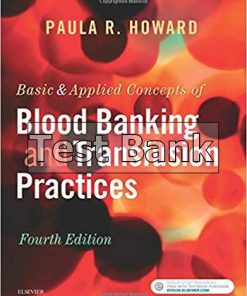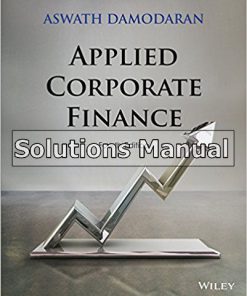Financial Institutions Management 4th Edition SAUNDERS Solutions Manual
$26.50$50.00 (-47%)
Financial Institutions Management 4th Edition SAUNDERS Solutions Manual.
You may also like
Financial Institutions Management 4th Edition SAUNDERS Solutions Manual

Product details:
- ISBN-10 : 0072486198
- ISBN-13 : 978-0072486193
- Author: Anthony Saunders
Saunders and Cornett’s Financial Institutions Management: A Risk Management Approach 4/e focuses on managing return and risk in modern financial institutions. The central theme is that the risks faced by financial institutions managers and the methods and markets through which these risks are managed are becoming increasingly similar whether an institution is chartered as a commercial bank, a savings bank, an investment bank, or an insurance company. Although the traditional nature of each sector’s product activity is analyzed, a greater emphasis is placed on new areas of activities such as asset securitization, off-balance-sheet banking, and international banking.
Table contents:
- PART 1 Introduction
- CHAPTER 1 Why are financial institutions special?
- Introduction
- Financial institutions’ specialness
- FI function as broker
- FI function as asset transformer
- Information costs
- Liquidity and price risk
- Other special services
- Other aspects of specialness
- The transmission of monetary policy
- Credit allocation
- Intergenerational wealth transfers or time intermediation
- Payment services
- Denomination intermediation
- Specialness and regulation
- Safety and soundness regulation
- Monetary policy regulation
- Credit allocation regulation
- Consumer and investor protection regulation
- Entry regulation
- The changing dynamics of specialness
- Trends in Australia
- Global trends
- The rise of financial services holding companies
- The shift away from risk measurement and management and the global financial crisis
- Summary
- Key terms
- Questions and problems
- Web questions
- Pertinent websites
- Appendix 1A (online): The US sub-prime crisis, the global financial crisis and the failure of financial services institutions’ specialness
- Appendix 1B: Implementation of monetary policy by the Reserve Bank of Australia
- CHAPTER 2 The financial services industry: depository institutions
- Introduction
- Banks
- Size, structure and composition of the industry
- Balance sheet and trends
- Bank performance
- Credit unions and building societies
- Size, structure and composition of the industry
- Balance sheet, performance and trends
- The regulation of Australian depository institutions
- The key legislation
- The regulatory agencies
- Australian Prudential Supervision Framework
- Overview of the regulation of depository institutions
- Summary
- Key terms
- Questions and problems
- Web questions
- Pertinent websites
- Appendix 2A (online): Financial statement analysis using a return on equity framework
- CHAPTER 3 The financial services industry: other financial institutions
- Introduction
- Insurers and fund managers
- Life insurance
- General insurance
- Superannuation funds
- Managed funds and unit trusts
- Other financial institutions
- Money market corporations
- Finance companies
- Securitisation vehicles
- Summary
- Key terms
- Questions and problems
- Web questions
- Pertinent websites
- CHAPTER 4 Risks of financial institutions
- Introduction
- Interest rate risk
- Market risk
- Credit risk
- Country or sovereign risk
- Foreign exchange risk
- Liquidity risk
- Off-balance-sheet risk
- Technology and operational risks
- Technology risk
- Operational risk
- Insolvency risk
- Other risks and the interaction of risks
- Summary
- Key terms
- Questions and problems
- Web question
- Pertinent websites
- PART 2 Measuring and managing risk
- CHAPTER 5 Interest rate risk measurement: the repricing model
- Introduction
- The level and movement of interest rates
- The repricing model
- Rate-sensitive assets
- Rate-sensitive liabilities
- Changes to NII—equal changes in rates on RSAs and RSLs
- Changes to NII—unequal changes in rates on RSAs and RSLs
- Weaknesses of the repricing model
- Market value effects
- Over-aggregation
- The problem of runoffs
- Cash flows from off-balance-sheet activities
- Summary
- Key terms
- Questions and problems
- Web questions
- Integrated mini case
- Pertinent websites
- Appendix 5A (online): Maturity model
- Appendix 5B: Term structure of interest rates
- CHAPTER 6 Interest rate risk measurement: the duration model
- Introduction
- Duration: a simple introduction
- A general formula for duration
- The duration of interest-bearing bonds
- The duration of a zero-coupon bond
- The duration of a consol bond (perpetuity)
- Features of duration
- Duration and maturity
- Duration and yield
- Duration and coupon interest
- The economic meaning of duration
- Semi-annual coupon bonds
- Using duration to measure an FI’s interest rate risk
- Duration and immunising future payments
- Duration and interest rate risk in the whole balance sheet of an FI
- Immunisation and regulatory considerations
- Difficulties of applying the duration model
- Duration matching can be costly
- Immunisation is a dynamic problem
- Large interest rate changes and convexity
- Summary
- Key terms
- Questions and problems
- Integrated mini case
- Pertinent websites
- Appendix 6A (online): The basics of bond valuation
- Appendix 6B: Incorporating convexity into the duration model
- CHAPTER 7 Managing interest rate risk using off-balance-sheet instruments
- Introduction
- Forward and futures contracts
- Spot contracts
- Forward contracts
- Futures contracts
- Forward contracts and hedging interest rate risk
- Hedging interest rate risk with futures contracts
- Microhedging
- Macrohedging
- Routine hedging versus selective hedging
- Macrohedging with futures
- The problem of basis risk
- Options contracts
- Basic features of options
- Buying a call option on a bond
- Writing a call option on a bond
- Buying a put option on a bond
- Writing a put option on a bond
- Writing versus buying options
- Economic reasons for not writing options
- Regulatory reasons for not writing options
- Futures versus options hedging
- The mechanics of hedging a bond or bond portfolio using options
- Hedging with bond options using the binomial model
- Actual bond options
- Using options to hedge the interest rate risk of the balance sheet
- Basis risk
- Interest rate swaps
- Swap markets
- The generic interest rate swap
- Realised cash flows on an interest rate swap
- Macrohedging with swaps
- Interest rate swaps and credit risk concerns
- Summary
- Key terms
- Questions and problems
- Web questions
- Integrated mini case
- Pertinent websites
- Appendix 7A (online): Microhedging with futures
- Appendix 7B (online): Black–Scholes option pricing model
- Appendix 7C (online): Microhedging with options
- Appendix 7D (online): Setting rates on an interest rate swap
- CHAPTER 8 Managing interest rate risk using loan sales and securitisation
- Introduction
- Loan sales
- Types of loan sales contracts
- Using a loan sale to manage interest rate risk
- Why FIs sell loans
- Factors encouraging loan sales growth in the future
- Securitisation
- Converting on-balance-sheet assets to a securitised asset
- The pass-through security
- Prepayment risk on pass-through securities
- Prepayment models
- The collateralised mortgage obligation (CMO)
- The mortgage-backed bond (MBB)
- Can all assets be securitised?
- Summary
- Key terms
- Questions and problems
- Web questions
- Pertinent websites
- Appendix 8A (online): Option-related prepayment models
- Appendix 8B (online): Mortgage pass-through strips
- CHAPTER 9 Market risk
- Introduction
- Calculating market risk exposure
- The RiskMetrics model
- The market risk of fixed-income securities
- Foreign exchange
- Equities
- Portfolio aggregation
- The historic (back simulation) approach
- The historic (back simulation) model versus RiskMetrics
- The Monte Carlo simulation approach
- Expected shortfall
- Regulatory models: the BIS standardised framework
- Partial risk factor approach
- Fuller risk factor approach
- The BIS regulations and large bank internal models
- Summary
- Key terms
- Questions and problems
- Web question
- Integrated mini case
- Pertinent websites
- CHAPTER 10 Credit risk I: individual loan risk
- Introduction
- Credit quality problems
- Types of loans
- Business loans
- Housing loans
- Consumer or individual loans
- Other loans
- Loan defaults
- Calculating the return on a loan
- The contractually promised return on a loan
- The expected return on a loan
- Retail versus wholesale credit decisions
- Retail
- Wholesale
- Measurement of credit risk
- Default risk models
- Qualitative models
- Quantitative models
- Newer models of credit risk measurement and pricing
- Term structure derivation of credit risk
- Mortality-rate derivation of credit risk
- RAROC models
- Using duration to estimate loan risk
- Using loan default rates to estimate loan risk
- Option models of default risk
- Summary
- Key terms
- Questions and problems
- Web questions
- Integrated mini case
- Pertinent websites
- Appendix 10A (online): Credit analysis
- CHAPTER 11 Credit risk II: loan portfolio and concentration risk
- Introduction
- Simple models of loan concentration risk
- Loan portfolio diversification and modern portfolio theory (MPT)
- Moody’s Analytics portfolio manager model
- Partial applications of portfolio theory
- Regulatory models
- Use of derivatives to hedge credit risk
- Credit forward contracts and credit risk hedging
- Hedging credit risk with options
- Credit swaps
- Swaps and credit risk concerns
- Use of loan sales and securitisation to manage credit risk
- Removal of credit risk
- Reduction of concentration risk
- Maintenance of customer relationships
- Capital adequacy regulations
- Moral hazard issues
- Summary
- Key terms
- Questions and problems
- Web questions
- Integrated mini case
- Pertinent websites
- Appendix 11A (online): CreditMetrics
- Appendix 11B (online): Credit risk+
- CHAPTER 12 Sovereign risk
- Introduction
- Credit risk versus sovereign risk
- Debt repudiation versus debt rescheduling
- Country risk evaluation
- Outside evaluation models
- Internal evaluation models
- Using market data to measure risk: the secondary market for LDC and emerging market debt
- The structure of the market
- The early market for sovereign debt
- Today’s market for sovereign debt
- Summary
- Key terms
- Questions and problems
- Web questions
- Pertinent websites
- Appendix 12A (online): Mechanisms for dealing with sovereign riskexposure
- CHAPTER 13 Foreign exchange risk
- Introduction
- Foreign exchange rates and transactions
- Foreign exchange rates
- Foreign exchange transactions
- Sources of foreign exchange risk exposure
- Foreign exchange rate volatility and FX exposure
- Foreign currency trading
- FX trading activities
- Interaction of interest rates, inflation and exchange rates
- Purchasing power parity
- Interest rate parity
- Foreign asset and liability positions
- The return and risk of foreign investments
- Risk and hedging
- On-balance-sheet hedging
- Managing FX risk using derivative instruments
- Hedging with forwards
- Hedging with futures
- Estimating the hedge ratio
- Using options to hedge FX risk
- Using currency swaps to hedge FX risk
- Multicurrency foreign asset–liability positions
- Summary
- Key terms
- Questions and problems
- Web question
- Pertinent websites
- CHAPTER 14 Liquidity risk
- Introduction
- Causes of liquidity risk
- Liquidity risk at depository institutions
- Liability-side liquidity risk
- Asset-side liquidity risk
- Measuring a depository institution’s liquidity exposure
- Liquidity planning
- Liquidity risk, unexpected deposit drains and bank runs
- Bank runs, the discount window and deposit guarantees
- Liquidity and financial system stability
- Liquidity risk in other financial institutions
- Life insurance companies
- General insurers
- Managed funds
- Summary
- Key terms
- Questions and problems
- Web question
- Pertinent websites
- CHAPTER 15 Liability and liquidity management
- Introduction
- Liquid asset management
- Monetary policy implementation reasons
- Taxation reasons
- The composition of the liquid asset portfolio
- Return–risk trade-off for liquid assets
- The liquid asset reserve management problem for depository institutions
- Management of exchange settlement funds
- Liquidity management as a knife-edge management problem
- Liability management
- Funding risk and cost
- Choice of liability structure
- Deposit liabilities
- Cheque account and other demand deposits
- Savings accounts
- Cash management/investment savings accounts
- Fixed-term deposits
- Negotiable certificates of deposit (NCDs)
- Non-deposit liabilities
- Interbank funds
- Repurchase agreements (Repos)
- Covered bonds
- Other borrowings
- Liquidity regulation
- Minimum quantitative requirements
- LCR regime ADIs
- MLH regime ADIs
- Net stable funding ratio (NSFR)
- Improved global liquidity?
- Depositor protection and deposit guarantees
- Australian depositor protection mechanisms
- Summary
- Key terms
- Questions and problems
- Web questions
- Pertinent websites
- CHAPTER 16 Off-balance-sheet risk
- Introduction
- OBS activities and FI solvency
- Returns and risks of OBS activities
- Loan commitments
- Documentary letters of credit and standby letters of credit
- Derivative contracts: futures, forwards, swaps and options
- Forward purchases and sales of when-issued securities
- Loans sold
- The role of OBS activities in reducing risk
- Summary
- Key terms
- Questions and problems
- Web question
- Integrated mini case
- Pertinent websites
- CHAPTER 17 Technology and other operational risks
- Introduction
- What are the sources of operational risk?
- Technological innovation and profitability
- The impact of technology on wholesale and retail financial service production
- Wholesale financial services
- Retail financial services
- Advanced technology requirements
- The effect of technology on revenues and costs
- Technology and revenues
- Technology and costs
- Testing for economies of scale and economies of scope
- The production approach
- The intermediation approach
- Empirical findings on cost economies of scale and scope and implications for technology expenditures
- Economies of scale and scope and X-inefficiencies
- Technology and the payments system
- Trends in retail payments
- Trends in high-value payments
- Risks that arise in an electronic payment system
- Other operational risks
- Regulatory issues and technology and operational risks
- Operational risk and FI insolvency
- Consumer protection
- Summary
- Key terms
- Questions and problems
- Web questions
- Pertinent websites
- Appendix 17A (online): Selection of research articles on the efficiency of Australian financial institutions
- CHAPTER 18 Capital management and adequacy
- Introduction
- Capital and insolvency risk
- Capital
- The market value of capital
- The book value of capital
- The discrepancy between the market and book values of equity
- Arguments against market value accounting
- Capital management
- Regulation of capital of Australian DIs
- Basel accords: The evolution of DI capital regulation
- Pillar 1: Capital adequacy
- Measurement of regulatory capital
- Measuring risk-adjusted assets
- Calculating the capital adequacy ratios
- Leverage ratio
- Capital buffers
- Pillar 2: DI risk assessment and supervision
- Pillar 3: Capital and risk disclosure
- Summary
- Key terms
- Questions and problems
- Web questions
- Pertinent websites
- Appendix 18A: Market risk capital charge for interest rate risk using the standardised approach
- Appendix 18B: Criticisms of the risk-based capital ratio
- Appendix 18C (online): Capital regulation of life insurers and general insurers
- Glossary
- Index
People also search:
financial institutions management 4th edition pdf download
risk management and financial institutions 4th edition pdf
risk management and financial institutions 4th edition
4 functions of financial management
4 types of financial institution












